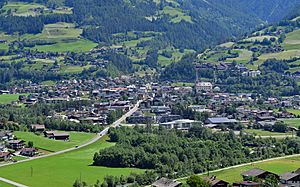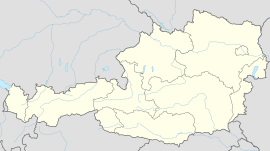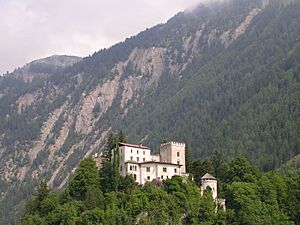Matrei in Osttirol facts for kids
Quick facts for kids
Matrei in Osttirol
|
||
|---|---|---|
 |
||
|
||
| Country | Austria | |
| State | Tyrol | |
| District | Lienz | |
| Area | ||
| • Total | 277.77 km2 (107.25 sq mi) | |
| Elevation | 975 m (3,199 ft) | |
| Time zone | UTC+1 (CET) | |
| • Summer (DST) | UTC+2 (CEST) | |
| Postal code |
9971
|
|
| Area code | 04875 | |
| Vehicle registration | LZ | |
| Website | www.matrei-ost.tirol.gv.at | |
Matrei in Osttirol is a small town in the Lienz District of Austria. It's located in the state of Tyrol, specifically in a part called East Tyrol. This town is about 29 kilometers (18 miles) north of Lienz.
Matrei is nestled in the beautiful Hohe Tauern mountain range, which is part of the Central Eastern Alps. Its area includes parts of the Granatspitze Group and the Venediger Group. The highest point in the area is the Großvenediger peak, which stands tall at 3,657 meters (11,998 feet). Most people in Matrei work in tourism, farming (especially seasonal farming where animals move to different pastures), and forestry (managing forests).
Contents
Where is Matrei in Osttirol?
Matrei in Osttirol is surrounded by other interesting places. To the north, you'll find towns like Neukirchen am Großvenediger and Mittersill. To the east is Kals am Großglockner, and to the west are Prägraten am Großvenediger and Virgen. South of Matrei are places like Sankt Veit in Defereggen and Hopfgarten in Defereggen.
A Look at Matrei's Past
Early Beginnings and Name Changes
The town of Matrei was first mentioned in official papers way back in 1170. Its name comes from an old word, mater, meaning "mother." Later, in 1335, it was called Windisch Matrei. This was to tell it apart from another town called Matrei am Brenner, which is in North Tyrol. The word "Windisch" referred to the Slavs, who were people living in the area a long time ago. This name, Windisch Matrei, was used officially until 1921.
Becoming Part of Different Lands
In the middle of the 700s, a Slavic area called Carantania became part of a larger German region known as Bavaria. Bavaria then joined the Frankish Carolingian Empire in 788. Christian missionaries from the Archdiocese of Salzburg (a church region) helped spread Christianity in East Tyrol. In 811, Emperor Charlemagne confirmed that Salzburg had influence over this area.
After the Carolingian Empire broke apart in the 800s, Matrei became part of a county called Lurngau, which was still part of Bavaria.
Salzburg's Influence
In 976, the land became part of the Duchy of Carinthia. However, from 1207 onwards, the Archbishops of Salzburg (who were powerful church leaders) took control of Matrei. This made Matrei a special area belonging to Salzburg, even though it was south of the main Alpine mountains. This caused some problems with the Counts of Tyrol, who were trying to expand their own lands nearby.
In 1252, Count Meinhard I of Gorizia-Tyrol tried to take over Matrei. But in the end, he had to give up his claims to Salzburg. The church leaders managed Matrei through a special officer called a burgrave, who lived at Weißenstein Castle.
Challenges and Changes
Even though Matrei was given "market rights" (meaning it could hold markets), it was quite cut off from the rest of Tyrol. It was also hard to reach from the nearby Salzburg region because of the high mountains. This meant that trading was difficult, and many people in the countryside faced tough times. They even had several revolts against the church's rule, starting with the German Peasants' War in 1525 and continuing into the 1700s.
During the Napoleonic Wars, the last Prince-Archbishop of Salzburg, Count Hieronymus von Colloredo, had to flee in 1800. In 1803, the archbishopric lost its power, and in 1805, Matrei became part of the Austrian Empire.
Joining Tyrol and Modern Times
In 1814, Emperor Francis I of Austria decided that Matrei should officially become part of Tyrol. This ended 600 years of Matrei being separate. Even so, it remained a rural area. In the mid-1800s, mountaineering (climbing mountains) started to become popular, bringing some tourists. The first time someone successfully climbed the Großvenediger peak was in 1865. Getting to Matrei became much easier when the Felbertauern road tunnel was built in 1967.
How Many People Live Here?
The number of people living in Matrei in Osttirol has changed over time.
| Historical population | ||
|---|---|---|
| Year | Pop. | ±% |
| 1869 | 2,372 | — |
| 1880 | 2,328 | −1.9% |
| 1890 | 2,297 | −1.3% |
| 1900 | 2,297 | +0.0% |
| 1910 | 2,310 | +0.6% |
| 1923 | 2,301 | −0.4% |
| 1934 | 2,610 | +13.4% |
| 1939 | 2,650 | +1.5% |
| 1951 | 3,404 | +28.5% |
| 1961 | 3,430 | +0.8% |
| 1971 | 4,003 | +16.7% |
| 1981 | 4,293 | +7.2% |
| 1991 | 4,521 | +5.3% |
| 2001 | 4,903 | +8.4% |
| 2011 | 4,798 | −2.1% |
Images for kids
See also
 In Spanish: Matrei in Osttirol para niños
In Spanish: Matrei in Osttirol para niños





